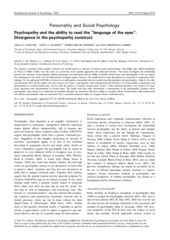| dc.contributor.author | Sandvik, Asle Makoto | |
| dc.contributor.author | Hansen, Anita Lill | |
| dc.contributor.author | Johnsen, Bjørn Helge | |
| dc.contributor.author | Laberg, Jon Christian | |
| dc.date.accessioned | 2014-09-02T13:18:24Z | |
| dc.date.available | 2014-09-02T13:18:24Z | |
| dc.date.issued | 2014 | eng |
| dc.identifier.issn | 1467-9450 | |
| dc.identifier.uri | https://hdl.handle.net/1956/8397 | |
| dc.description.abstract | The capacity to interpret others people’s behavior and mental states is a vital part of human social communication. This ability, also called mentalizing or Theory of Mind (ToM), may also serve as a protective factor against aggression and antisocial behavior. This study investigates the relationship between two measures of psychopathy (clinical assessment and self-report) and the ability to identify mental states from photographs of the eye region. The participants in the study were 92 male inmates at Bergen prison, Norway. The results showed some discrepancy in connection to assessment methodology. For the self-report (SRP-III), we found an overall negative association between mental state discrimination and psychopathy, while for the clinical instrument (PCL-R) the results were more mixed. For Factor 1 psychopathic traits (interpersonal and affective), we found positive associations with discrimination of neutral mental states, but not with the positive or negative mental states. Factor 2 traits (antisocial lifestyle) were found to be negatively associated with discrimination of mental states. The results from this study demonstrate a heterogeneity in the psychopathic construct where psychopathic traits related to an antisocial and impulsive lifestyle are associated with lower ability to recognize others’ mental states, while interpersonal and affective psychopathic traits are associated with a somewhat enhanced ability to recognize others’ emotional states. | en_US |
| dc.language.iso | eng | eng |
| dc.publisher | Wiley | eng |
| dc.relation.ispartof | <a href="http://hdl.handle.net/1956/8398" target="_blank">Psychopathy - the heterogeneity of the construct</a> | eng |
| dc.rights | Attribution-NonCommercial-NoDerivs CC BY-NC-ND | eng |
| dc.rights.uri | http://creativecommons.org/licenses/by-nc-nd/3.0/ | eng |
| dc.subject | Psychopathy | eng |
| dc.subject | Aggression | eng |
| dc.subject | PCL-R | eng |
| dc.subject | SRP-III | eng |
| dc.subject | Reading the Mind in the Eyes Test | eng |
| dc.subject | Theory of mind | eng |
| dc.title | Psychopathy and the ability to read the “language of the eyes”: Divergence in the psychopathy construct | eng |
| dc.type | Peer reviewed | |
| dc.type | Journal article | |
| dc.description.version | publishedVersion | |
| dc.rights.holder | Copyright the authors | |
| dc.identifier.doi | https://doi.org/10.1111/sjop.12138 | |
| dc.identifier.cristin | 1139884 | |
| dc.source.journal | Scandinavian Journal of Psychology | |

